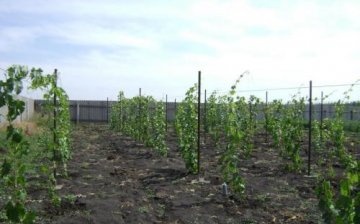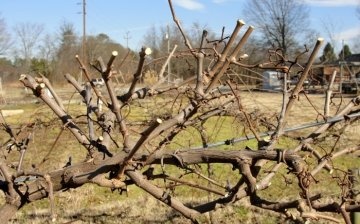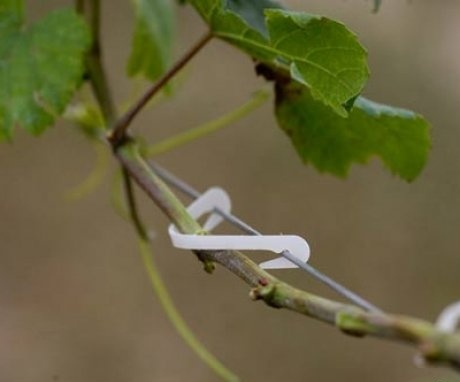Grape processing in spring
Grapes are difficult enough to grow. It is light and thermophilic and is susceptible to many diseases and pests. Therefore, it is necessary to process the grapes in spring. After removing winter shelter plants are immediately treated with a solution of ferrous sulfate from numerous pests. It is important to do this before the buds open.
Content:
- Spring pruning of grapes
- Spring garter of grapes
- Treatment of grapes from pests and diseases
- Spring feeding of grapes
Also, you need to break out the frozen, sick and weak shoots, carry out sanitary pruning, and then a garter. With the appearance of the first tears, it is necessary to make the first feeding grapes.
Spring pruning of grapes
Spring pruning grapes are carried out with the aim of the normal development of the bush and obtaining a good harvest. The temperature during the pruning of the vine should not be lower than 3 degrees, when there is no fear that frosts will come. Pruning tools are: garden shears (pruning shears) and a garden hacksaw.
To make the cut of high quality, the secateurs are held from the side of the part to be left. When the perennial part of the bush is removed, a stump of several centimeters is left so that the tissue at the cut site does not die. All buds are removed from the stumps.
In order to form a bush, the two uppermost shoots are chosen, which go in different directions. These are the fruit arrows, the diameter of which is approximately 3/4 cm. The ideal vine is considered, on which the buds are located at the same distance from each other. Two shoots are left under the fruit arrows, which will serve as replacement knots. 2-4 kidneys are left on them.
This type of trimming is called multi-sleeve trim. Another type of vine pruning is widespread - fan-shaped. The formation of such a bush consists in the fact that four shoots are selected with an arrangement of two on each side. Both with multi-arm and fan formation of a bush, pruning is done so that from 6 to 12 buds are placed on each upper fruiting vine. 4 buds are left on the lower fruiting branches.
Standard fan pruning is performed on grape bushes that have reached 3 years of age. As a result, 4 fruitful vines and 4 replacement knots are obtained.
Spring garter of grapes
After the grape bush has been pruned, they begin to garter it. It is carried out using tissue flaps. Rope or nylon fishing line, which are often used for these purposes, damage the vines in the places of their garter. The first spring garter is done before the shoots start growing, otherwise young fragile shoots break, which leads to a decrease in grape yield. This garter is called "dry".
Fertile shoots are carefully bent to the bottom row of wire horizontally and tied with an eight-shaped loop. This arrangement stimulates the uniform growth of young shoots. As soon as they grow 20-25 cm, they are tied to the top rows of wire. Since the work is done with green shoots, the garter is called "green". Every 15 days, the procedure is repeated to prevent drooping and damage to the shoots.
Treatment of grapes from pests and diseases
Once pruned and tied, the vines are ready for spraying to protect them from disease and pests.For this purpose, 300-500 g of ferrous sulfate are diluted in 10 liters of water. The next step leaving is loosening the soil to a depth of 20 cm.
In early May, when the grapes have not yet bloomed, they are re-treated against pests with chemicals. Those who do not accept chemical treatment usually use milk diluted with water, sprinkling the grapes every week until flowering.
If it is very hot outside and it suddenly rained, it is better to immediately process the grapes with Bordeaux liquid or copper sulfate, otherwise the grapes may get sick, since they do not like it when water gets on the leaves. It is recommended to water the grapes at the root.
Spring feeding of grapes
Spring feeding of grapes is done twice: the first - when tears appear, the second - before flowering. The first feeding of the grapes is necessary for recuperation after wintering, and the second - for the supply of those nutrients that are so necessary during the flowering period. The second top dressing helps to increase the quantity and quality of the grapes.
The simplest feeding recipe is prepared in this way:
- 2 parts mullein or chicken droppings are mixed with 3 parts water in a plastic barrel;
- the fermentation process takes about two weeks;
- mix the mass daily;
- before being introduced under the grape bush, 1 liter of the fermented mass is diluted in 10 liters of water;
- a liter can of wood ash is added to the solution.
Before feeding, a bucket of water is poured under the bush, and after a bucket of feeding, a bucket of water is again poured.
Before flowering, in addition to the second top dressing, it is necessary to carry out secondary loosening of the soil, now to a shallower depth, 10-15 centimeters. You cannot handle grapes in cold weather and during flowering, this can lead to the loss of flowers, and, therefore, the entire harvest. At the end of flowering, the grapes are again treated with Bordeaux liquid or a solution of ferrous sulfate.
If all the procedures for spring care of grape bushes are performed correctly, then in the fall it will present surprisingly large and fragrant bunches.













